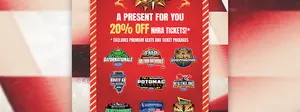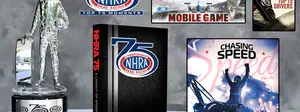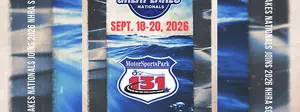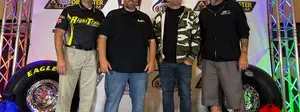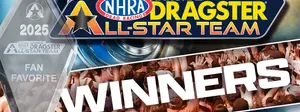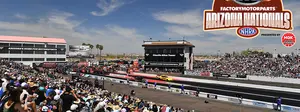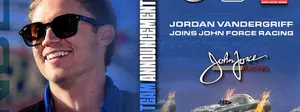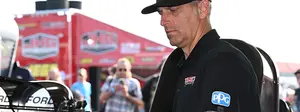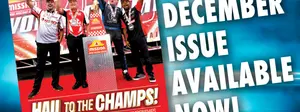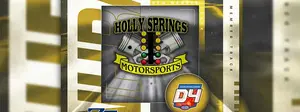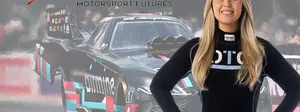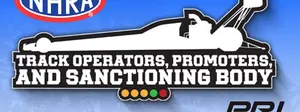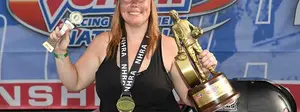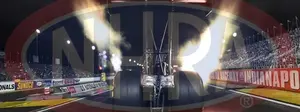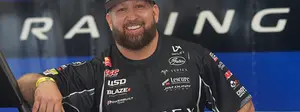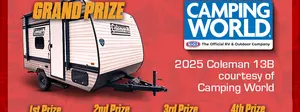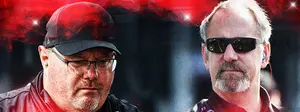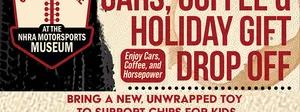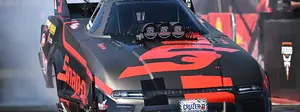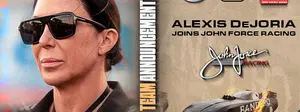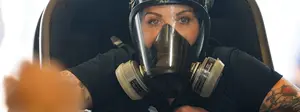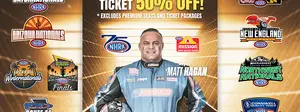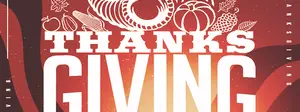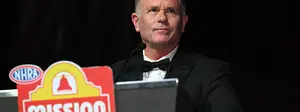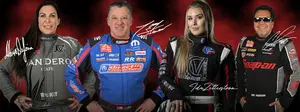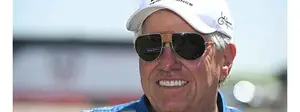

Liberman Vega voted top Funny Car of all time

Earlier this year, fans voted on a Top 20 list developed by respected drag racing historians and Funny Car experts. The results have been revealed in reverse order at NHRA national events this season and simultaneous to a separate but parallel list created by former NHRA Funny Car champion and current NHRA FOX television analyst Tony Pedregon. Pedregon's top vote also went to Liberman's Vega.
Here are the final results:
NHRA Fan Vote Top 20
1. “Jungle Jim” Liberman Vega (1973)
Drag racing’s premier showman wowed fans from coast to coast with this car, performing crowd-pleasing fire burnouts and racking up an impressive win-loss record on the match race scene.
1. “Jungle Jim” Liberman Vega (1973)
Drag racing’s premier showman wowed fans from coast to coast with this car, performing crowd-pleasing fire burnouts and racking up an impressive win-loss record on the match race scene.
2. John Force Castrol Firebird (1996)
Force set atill-existing class records in 1996 with this entry, scoring 13 wins in 19 events en route to yet another championship.
3. Dale Pulde War Eagle Trans Am (1977)
Force set atill-existing class records in 1996 with this entry, scoring 13 wins in 19 events en route to yet another championship.
3. Dale Pulde War Eagle Trans Am (1977)
One of the prettiest cars to ever grace the dragstrip and a steady performer in multiple series. The car set the NHRA national speed record at 245 mph.
4. Don Prudhomme Army Monza (1975-76)
On a per-race basis, one of the most successful cars to compete, winning 13 of 16 events and two championships in 1975-76. The car also made the sport’s first five-second Funny Car pass.
5. Raymond Beadle Blue Max Mustang II (1975)
4. Don Prudhomme Army Monza (1975-76)
On a per-race basis, one of the most successful cars to compete, winning 13 of 16 events and two championships in 1975-76. The car also made the sport’s first five-second Funny Car pass.
5. Raymond Beadle Blue Max Mustang II (1975)
Beadle went from journeyman racer to superstar with the resurrection of the famed Blue Max name and was Don Prudhomme’s toughest rival in the mid- to late 1970s.
6. Don Prudhomme Hot Wheels Barracuda (1970)
6. Don Prudhomme Hot Wheels Barracuda (1970)
“The Snake” and partner Tom McEwen brought Corporate America to the dragstrip through their deal with Mattel-backed Funny Cars, and the former dragster drivers became household names and brought drag racing into living rooms around the world.
7. Don Nicholson's Comet (1966)
The sport’s first flip-top car, it forever changed the basic look of the class: a tilt-up body hiding a tube-frame chassis and a thumping nitro engine. The car was a terror on the track, too, challenged only by Mercury teammate Eddie Schartman.
8. Chi-Town Hustler Charger (1969)
The car largely credited with creating the performance-enhancing burnout was a popular and successful match race machine with Pat Minick at the wheel and Hall of Famer Austin Coil turning wrenches.
9. Kenny Bernstein “Batmobile” Buick (1987)
7. Don Nicholson's Comet (1966)
The sport’s first flip-top car, it forever changed the basic look of the class: a tilt-up body hiding a tube-frame chassis and a thumping nitro engine. The car was a terror on the track, too, challenged only by Mercury teammate Eddie Schartman.
8. Chi-Town Hustler Charger (1969)
The car largely credited with creating the performance-enhancing burnout was a popular and successful match race machine with Pat Minick at the wheel and Hall of Famer Austin Coil turning wrenches.
9. Kenny Bernstein “Batmobile” Buick (1987)
Bernstein and crew chief Dale Armstrong broke the mold – almost literally – with this car that took advantage of every loophole in the Rulebook with a wider and higher rear deck that created a lot of downforce with very little aerodynamic drag. Ugly to a fault but beautiful in results, the car was legal only for one season, but the ideas it inspired live on.
10. Jack Beckman's Infinite Hero Dodge (2015)
10. Jack Beckman's Infinite Hero Dodge (2015)
Beckman and crew chief Jimmy Prock shook up the Funny Car ranks in mid-2015, moving the needle on what had been a stagnant performance barrier and not only repeatedly lowering the class e.t. mark but also inspiring the rest of the class to follow suit, leading to unprecedented leaps in performance over four months.
11. Jim Dunn/Dunn & Reath Barracuda (1972)
The first and only rear-engine Funny Car to win a national event (1972 Supernationals), the car also was the star of a feature film, Funny Car Summer, that exposed the masses to the sport. The combination of savvy Dunn’s handling skills and a Woody Gilmore design opened up endless possibilities, but their success was never duplicated.
11. Jim Dunn/Dunn & Reath Barracuda (1972)
The first and only rear-engine Funny Car to win a national event (1972 Supernationals), the car also was the star of a feature film, Funny Car Summer, that exposed the masses to the sport. The combination of savvy Dunn’s handling skills and a Woody Gilmore design opened up endless possibilities, but their success was never duplicated.
12. Ramchargers/Goldstein Dodge Challenger (1970)
The Ramchargers brought its engine savvy to the Funny Car class after years in Top Fuel and created a winning combination with driver Leroy Goldstein. The car broke the six-second barrier in June 1970.
The Ramchargers brought its engine savvy to the Funny Car class after years in Top Fuel and created a winning combination with driver Leroy Goldstein. The car broke the six-second barrier in June 1970.
13. Pat Foster/Barry Setzer Vega (1972)
Although Foster’s national event statistics don’t bear it out, the pretty maroon and gold Vega, owned by textile magnate Setzer, was the baddest Funny Car on the planet in 1972-73, running low e.t. almost everywhere it went.
Although Foster’s national event statistics don’t bear it out, the pretty maroon and gold Vega, owned by textile magnate Setzer, was the baddest Funny Car on the planet in 1972-73, running low e.t. almost everywhere it went.
14. Ed McCulloch Revellution Duster (1972)
This car, backed by Revell, maker of plastic model cars, really put “the Ace,” already a successful Funny Car pilot, on the map by winning four of eight events in 1972: the first three and the U.S. Nationals.
This car, backed by Revell, maker of plastic model cars, really put “the Ace,” already a successful Funny Car pilot, on the map by winning four of eight events in 1972: the first three and the U.S. Nationals.
15. Danny Ongais/Mickey Thompson Mustang (1969)
Built by Pat Foster, this car popularized the narrow-framerail chassis and dragster-style roll-cage design still used today. The car, along with Foster’s twin, was the first to use zoomie headers. The car won both the Springnationals and Nationals in 1969.
Built by Pat Foster, this car popularized the narrow-framerail chassis and dragster-style roll-cage design still used today. The car, along with Foster’s twin, was the first to use zoomie headers. The car won both the Springnationals and Nationals in 1969.
16. Kenny Bernstein's Budweiser King Tempo (1984)
Bernstein and crew chief Dale Armstrong spent hours in the Ford wind tunnel perfecting the aero shape of this car with rounded fenderwells, a full belly pan, enclosed side windows, and more, beginning an attention to aero detail that continues to this day.
Bernstein and crew chief Dale Armstrong spent hours in the Ford wind tunnel perfecting the aero shape of this car with rounded fenderwells, a full belly pan, enclosed side windows, and more, beginning an attention to aero detail that continues to this day.
17. Don Prudhomme's Pepsi Challenger (1982)
The first Funny Car to exceed 250 mph, it carried “the Snake” to two wins in 1982 and one of the greatest runs in class history, a stunning 5.63 clocking at the U.S. Nationals.
The first Funny Car to exceed 250 mph, it carried “the Snake” to two wins in 1982 and one of the greatest runs in class history, a stunning 5.63 clocking at the U.S. Nationals.
18. Jim White/Hawaiian Dodge (1991)
Any number of Roland Leong’s Hawaiian entries could have made this list, but the White-driven Hawaiian Punch Daytona was a standout, running the class’ first 290-mph pass and winning both the Big Bud Shootout and U.S. Nationals in the same weekend en route to a second-place championship finish.
Any number of Roland Leong’s Hawaiian entries could have made this list, but the White-driven Hawaiian Punch Daytona was a standout, running the class’ first 290-mph pass and winning both the Big Bud Shootout and U.S. Nationals in the same weekend en route to a second-place championship finish.
19. Gene Snow Rambunctious Challenger (1970)
“The Snowman’s” direct-drive Dodge was the unchallenged king of top speeds in the late 1960s and early 1970s and enjoyed success in multiple sanctioning bodies, including a three-win NHRA season that culminated in the class’ first NHRA world championship.
“The Snowman’s” direct-drive Dodge was the unchallenged king of top speeds in the late 1960s and early 1970s and enjoyed success in multiple sanctioning bodies, including a three-win NHRA season that culminated in the class’ first NHRA world championship.
20. Jack Chrisman Comet (1967)
Two years after blowing fans away with his original stock-appearing nitro-burning Comet at the 1964 Nationals, Chrisman’s lightweight flip-top Comet, with considerable engine setback, ran 190-mph speeds.
Two years after blowing fans away with his original stock-appearing nitro-burning Comet at the 1964 Nationals, Chrisman’s lightweight flip-top Comet, with considerable engine setback, ran 190-mph speeds.
Tony Pedregon’s Top 20
1. Jim Liberman Vega (1973)
2. Raymond Beadle Blue Max Arrow (1979)
3. Don Prudhomme Army Arrow (1878)
4. John Force Castrol Firebird (1996)
5. Kenny Bernstein Budweiser King Tempo (1985)
6. Pat Foster/Barry Setzer Vega (1972)
7. "Big John" Mazmanian Barracuda (1968)
8. Tony Pedregon/Castrol/KISS Ford Mustang (2003)
9. Cruz Pedregon McDonald's Olds Cutlass (1992)
10. Lil John Lombardo Mustang II (1976)
11. "TV Tommy" Ivo Nationwise Dodge (1976)
12. Bruce Larson USA-1 Camaro (1969)
13. Roland Leong/Ron Colson Hawaiian Monza (1977)
14. Joe Pisano/Tom Ridings Arrow (1978)
15. Dale Pulde War Eagle Trans Am (1977)
16. Jim Green/Richard Rogers Green Elephant Vega (1977)
17. Gordie Bonin's Bubble-Up Trans Am (1977)
18. Al Segrini's Black Magic Vega (1974-75)
19. Dale Armstrong/Mike Kase Speed Racer Omni (1980-81)
20. Tom Prock’s Detroit Tiger Monza (1975-76)
1. Jim Liberman Vega (1973)
2. Raymond Beadle Blue Max Arrow (1979)
3. Don Prudhomme Army Arrow (1878)
4. John Force Castrol Firebird (1996)
5. Kenny Bernstein Budweiser King Tempo (1985)
6. Pat Foster/Barry Setzer Vega (1972)
7. "Big John" Mazmanian Barracuda (1968)
8. Tony Pedregon/Castrol/KISS Ford Mustang (2003)
9. Cruz Pedregon McDonald's Olds Cutlass (1992)
10. Lil John Lombardo Mustang II (1976)
11. "TV Tommy" Ivo Nationwise Dodge (1976)
12. Bruce Larson USA-1 Camaro (1969)
13. Roland Leong/Ron Colson Hawaiian Monza (1977)
14. Joe Pisano/Tom Ridings Arrow (1978)
15. Dale Pulde War Eagle Trans Am (1977)
16. Jim Green/Richard Rogers Green Elephant Vega (1977)
17. Gordie Bonin's Bubble-Up Trans Am (1977)
18. Al Segrini's Black Magic Vega (1974-75)
19. Dale Armstrong/Mike Kase Speed Racer Omni (1980-81)
20. Tom Prock’s Detroit Tiger Monza (1975-76)























